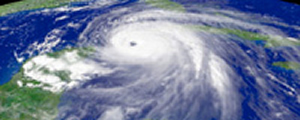 |
GETTING AN UP-TO-DATE WEATHER FORECAST BEFORE YOU TRAVEL (OR IN TIME TO PREPARE FOR CATACLYSMIC WEATHER WHILE AT HOME).
By: James G. Apple, Editor-in-Chief, International
Judicial Monitor and President, International Judicial Academy |
|
(In celebration
of the 100th anniversary of the founding of the American
Society of International Law in 2006, the Society published a small pamphlet
titled International Law: One Hundred Ways
It Shapes Our Lives. The Introduction
gives an explanation for its conception: an affirmation that “international law
not only exists, but also penetrates much more deeply and broadly into everyday
life than the people it affects may generally appreciate.” This column seeks to
elucidate and elaborate on many of the 100 ways briefly presented in the ASIL
pamphlet.)
 |
Hurricane Sandy,
in November, 2012, created much devastation along the East
Coast of the United States, especially in New Jersey and New York. However the
damage to houses, businesses, and such infrastructure facilities as subways,
power lines and power facilities, and telephone facilities would have been much
worse but for the timely weather forecasts for several days after the Hurricane
changed course in its northward progress and slammed into the coastal areas
of the Middle Atlantic region of the U.S.
The hurricane, which came late in the traditional U.S.
hurricane season that usually runs from August-September to November, and other
weather phenomena which so often plague geographic regions across the globe,
was again a painful reminder of the power of weather systems to greatly alter
the lives of persons in all parts of the world, and of the absolute necessity
of weather forecasting to reduce the damage and casualties of extreme weather
systems. Fortunately, an agency of the United Nations has as one of its basic
missions, the collection and dissemination of “high quality weather, climate,
water and related environmental predictions, information, warnings and services
in response to the users’ needs, and to enable their use in decision-making by relevant
societal sectors.” Because weather changing phenomenon are not limited to the
geographical areas where they occur, and can and do affect the weather in even
distant parts of the world, it is not enough to depend upon local weather
services to provide the necessary information for others outside the particular
locality.
The
system and organization that makes worldwide dissemination of weather
phenomena possible is the World Meteorological Organization (WMO) with headquarters in
Geneva, Switzerland.
The predecessor organization of the WMO was actually
established in the 19th Century, 20 years after the First
Meteorological Conference was held in Brussels, Belgium in 1853. That initial
organization, titled the International Meteorological Organization, was created in
Vienna in 1873. From that time the organization greatly developed and expanded
its activities until it became a specialized agency within the United Nations
system in 1951, following the drafting of the WMO Convention in 1947 and that
Convention coming into force three years later.
The first President of the WMO was F.W. Reichelderfer from
the United States, who served from 1951 to 1955. Successive presidents
exemplify the global nature of the organization: they have come from France,
Sweden, Egypt, Phillipines, China, Australia and Russia.
The WMO has had several significant milestones since it
became affiliated with the UN. The Global Ozone Observing System was set up
in 1957, which ultimately resulted in the first international assessment of the
state of global ozone in 1976 (which ultimately led to the Vienna Convention on
the Protection of the Ozone Layer in 1985, the Montreal Protocol on Substances
that Deplete the Ozone Layer two years later, and the subsequent banning of the
main chemical in refrigeration systems that caused depletion of ozone in the
atmosphere). The creation of the World Weather Watch was launched in 1963, a
cooperative effort to bring together in one place all of the weather information
gathered from countries in different parts of the world.

 International
Judicial Monitor
International
Judicial Monitor
